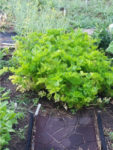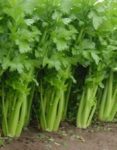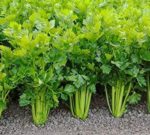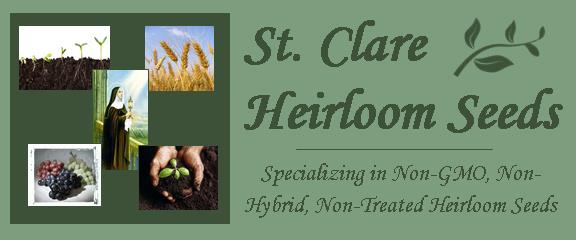Celery Seeds
Scroll down to see seeds for sale!
Ancient documents reveal that celery was originally from the Mediterranean area, and was cultivated for medicinal purposes before 850 B.C. to relieve pain, treat colds and flu, ease digestion issues, arthritis, and liver and spleen problems.
Domesticated by the Italians in the 17th century, celery stalks changed from hollow to solid, and became less bitter. After years of cultivation, early gardeners discovered cooler weather produced tastier and more tender stalks, especially if they were blanched.
The two main types of celery are self-blanching or yellow, and green (Pascal celery), which is most common in the United States. To produce yellow stalks, gardeners discovered they could ‘blanch’, or push up dirt around the base of the stalk to prevent sunlight from reaching the stalks and turning them green. Blanched celery tends to be tastier and crunchier and less stringy.
Often eaten raw with peanut butter as a snack, mixed in smoothies or salads, or served as celery sticks, often along with carrots. Celery is delicious added to soups, casseroles and stir-fry. The leaves are also edible and can be used for a colorful garnish for cocktails and soups, too, while celery seed is used as a spice to add a touch of celery flavor to a dish.
Celery is highly nutritious and contains vitamins A, B, C, K, fiber, folate, potassium, along with potent anti-inflammatory properties and antioxidants which fight auto-immune disease, cancer and cardiovascular disease, and can also lower blood pressure and cholesterol levels. Since celery is 95% water, it can help prevent dehydration, while the high fiber levels aid digestion. This vegetable is best eaten quickly after harvesting, as it loses nutrients quickly.
As celery is a warm weather plant, start your St. Clare’s heirloom celery seeds indoors around 8 to 10 weeks before your last frost.
Showing all 3 results
-

Celery – Golden Self Blanche
$2.89 View ProductAdd to cart(Apium graveolens) 85-100 days. Grows 25-30″ tall and is full-hearted with pale yellow/green stalks. The plants are stocky, solid, and thick, with the stalks blanching easily. The ribs are crunchy and tasty, without strings.
200 Seeds per pack
-

Celery – Tall Utah 52-70
$2.59 View ProductAdd to cart(Apium graveolens) 100-120 days. Tall Utah 52-70 Celery is an improved variety that grows taller, with longer ribs, deeper green color and sweeter than the original Utah. This celery does not require blanching. Tall Utah 52-70 is crisp, tender and tasty.
200 Seeds per pack
-

Celery – Tendercrisp
$2.89 View ProductAdd to cart(Apium graveolens) 90 -105 days. Tendercrisp Heirloom Open Pollinated Celery is a Giant Pascal type with a 24″ to 26″ tall massive head. Tendercrisp has smooth thick dark green stalks, 11 to 12″ to first joint. Good home garden variety.
200 Seeds per pack
Showing all 3 results

